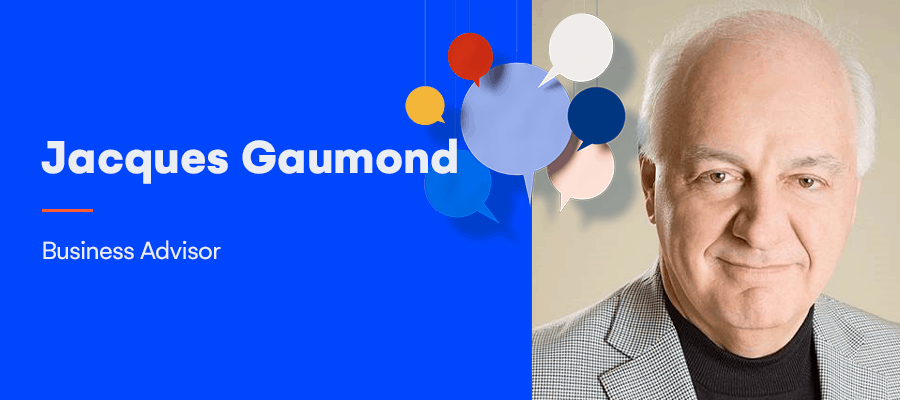Talent Management
Leading in thought: expert advice with Jacques Gaumond
15 March 2019

Thankfully, there are countless industry changing digital tools to help slow the HRD’s pace down somewhat, developed by industry thought-leaders, moving just as fast – if not faster than – the HRD itself. In such an in-depth industry, however, not many thought-leaders are willing to share insights – a stigma that needs to change.
Today we sat down with Jacques Gaumond, Business Advisor to Cegid’s executive management to discuss his prolific career within software and talent management as well as exciting trends to look out for in the future.
CEGID: Describe what drives and keeps you motivated toward your career.
Jacques Gaumond: What attracted me and keeps me motivated to work in, contribute to and continue to learn about the TM/HCM industry, is that I firmly believe that meaningful work is essential to a human being’s identity. In my opinion, it is feasible for companies to organize work not only to fulfill the company mission, serve and satisfy its clients and meet its stakeholders’ expectations but also to provide its employees with competitive compensation; bringing them closer to self-actualization and, above all, enjoyment of their work. As the industry evolves thanks to new technology, more complex societal needs and human behaviors, the TM/HCM industry will define how humans and machines will work together in an increasingly digitized world.
C: What do you like most about this industry?
JG: The fact that it combines both high-tech and high-touch, contributing to either making an organization strong, relevant and perennial or, in the case of less-fit organizations, swiftly redirecting workers toward better opportunities. This is what I love about TM/HCM.
C: In the last ten (10) years, what transformations have you seen within HR Talent Management solutions?
JG: For starters, many point solutions (support for single TM processes) have evolved to support multiple TM processes. Additionally, I’ve seen best-of-breed TM vendors being acquired by large ERP vendors. In turn, their best-of-breed TM suites have evolved to support additional platforms such as mobile devices and SaaS deployments, which makes a difference when you consider the powerful reporting and analysis capabilities of modern TM solutions. Leading vendors have also begun to incorporate Artificial Intelligence (AI) and Machine Learning (ML) capabilities in order to simplify, accelerate and enhance the way their solutions assist employees, managers and HR administrators.
C: How is this different from today?
JG: Suites continue to evolve and intensify. For example, leading TM Suite vendors are going far beyond functionality to include selective content and third-party service partners into TM ecosystems. Vendors are not only working with TM and HR data, but also with other internal and external [business] data to facilitate complex decision making about their people. We expect that [with the use of] AI and ML will assist not only with descriptive but also with predictive and prescriptive decision making.
C: Do you consider Cegid to be a leader in TM/HCM Suites?
JG: Absolutely, and I would contend that other industry experts would agree too. In fact, Cegid has been mentioned in reports from top Industry Analysts; some of which for a number of years.
For instance, Cegid has been mentioned for the 3rd consecutive years in both IDC’s MarketScape for Integrated Talent Management and Nucleus Research’sTM Technology Value Matrix. Cegid has also enjoyed 4 consecutive mentions in Gartner’s Magic Quadrant for Talent Management and two consecutive mentions in the Fosway Group’s 9-Grid for Integrated Talent Management.
Additionally, Aragon Research’s Globe for Corporate Learning has mentioned Cegid 5 times consecutively, IDC’s MarketScape for Learning Management, for Performance Management and for Compensation Management have all made mention of Cegid in 2018. Last but not least, Forrester’s Wave for Talent Acquisition of 2015. All of which are key industry analysis reports for single TM solutions.
Finally, Cegid was awarded the Brandon Hall Group’s Bronze Award for Technology in 2016.
C: In your opinion, what trends do you think lay ahead for Talent Management (with a specific focus on recruiting and onboarding) in 2019? List your top 5 and elaborate each point.
JG: After having sifted through multiple reports and industry data (trends, advancements etc.), in 2019 I foresee companies having to:
Embrace the fact that candidate experience is linked to higher job acceptance rates, better advocacy within their internal networks and high business impact potential. Data compiled by studies conducted by LinkedIn, Glassdoor and Talent Board have all pointed in this direction.
Increasingly use referral programs to attract and nurture external candidates for talent acquisition. Referral programs leveraging existing employees and company alumnae is one of – if not the– most cost-effective means of attracting candidates. Key benefits of these referral programs include reduced cost-per-hire, longer retention and better advocacy.
Deploy structured onboarding as part of their talent acquisition and talent mobility practices. Onboarding not only improves the candidate experience, but builds the bridge to employee experience, increasing employee retention.
Optimize data gathering methods and use AI to automate workflows. Using these technologies should result in reducing candidate search times, better matching of candidates to job requirements, less time to shortlist potential candidates and ultimately reduce the time needed to hire. In turn, bringing home a better-quality hire.
Adapt talent acquisition, work assignment and team management to accommodate more “Gig economy” workers. The “gig economy,” or freelancing at scale, is a growing trend in all industries, bringing with it its own advantages. In order to increasingly source and take advantage of this growing trend, companies need to adapt their practices. Today, organizations will need to go beyond standard job requirements and introduce well-defined project tasks, involve procurement to source freelance workers and ensure the collaboration of the internal team members with these gig workers.
C: What advice do you have for medium to large sized businesses who would like to acquire a talent management solution?
JG: Even if their business need is for a point-solution (i.e. supporting a single talent management process), a mid-sized organization should consider planning with a TM solution in mind. The reason being that talent management processes, from “hire to retire,” are all part of a continuum that works best when they’re seamlessly integrated. This is also a way for managers to see their employees and for employees to see themselves at work, for example, as valuable, whole contributors and team members with career aspirations.
Additionally, mid-sized organizations should assess where their industry stands when it comes to digitization and how this digitization can apply to HR functions. Any [modern] TM solution (Software as a Service or SaaS) can help mid-sized organizations automate and implement solutions for recruiting and onboarding processes; both of which sit at the top of today’s top-priority spectrum. Afterward, other TM processes can be added on to this same solution. At that point, mid-size companies can then shape their vision of a modern HR function, by virtue of real-time information that is fully and immediately accessible across multiple platforms, not just for employees and managers, but HR administrators as well.
When HR leadership has defined its talent vision and has been given ownership of it, needs and knowledge [of TM solutions] are refined and qualified vendors are vetted. Once an initial solution has been deployed, user experience is used to refine needs for subsequent deployments.
C: Finally, and this is more on the fun side of things, do you have a favorite quote?
JG: Oh, of course. “Grant me the serenity to accept the things I cannot change, the courage to change the things I can and the wisdom to know the difference.” – Adapted from Reinhold Niebuhr.
After a 25-year career in the international software and telecommunications industries, Jacques shifted his focus to the Talent Management / Human Capital Management (TM/HCM) industry, where he has spent the last 15 years in multiple roles, beginning as an executive for a global solutions provider and later moving on to become a management consultant, corporate director and, most recently, a business coach. In addition to his well-rounded experience, he has also kept abreast of major changes within the TM/HCM industry, keeping key industry thought-leadership and research findings top of mind. For the last three years, he has shifted his attention to work alongside leading industry analysts in both North America.


